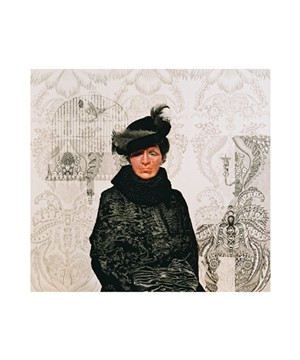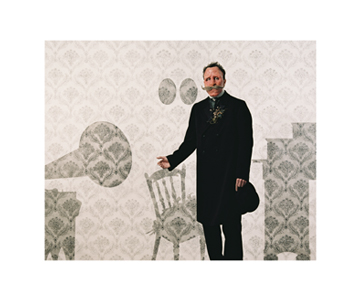 home about news archive cv publications
home about news archive cv publications
Monika Tress: Cadavre Exquis

German artist Monika Tress is educated as sculptor and in drawing. In her series Cadavre exquis: Remnants of existence she combines many of her techniques and involves a wide-ranging metaphorik toward a series of photos. Starting point are a XXXXX
Die in Ansbach geborene Künstlerin ist Bildhauerin und Zeichnerin. In ihrer jüngsten Arbeit "Cadavres exquis: Restposten der Existenz" verweben sich die verschiedenen Techniken mit weitgreifender Metaphorik zu einer fotografischen Serie, in der es um den Geltungsdrang des Individuums und die menschliche Vergänglichkeit geht. Ausgangspunkt sind anonyme Porträtfotografien um 1900, sog. cartes de visite, die in einem komplexen Bildgefüge nachgestellt werden.

People pose their way through life. We are how we appear and “the illusion is the flesh on things”. *
The seven-part photo series is based on a complex creation story: using photographic portraits of anonymous people taken around the eve of the 20th century Monika Tress develops a web of interwoven medial expression and ramified symbolism. Consequently, traces appear to take shape on the background behind those photographed of objects that no longer exist, of furniture or even animals, paradox as that may seem. Traces of times past that allow the wallpaper to become a film onto which fragments of a life have become engraved. Unlike the usual mass-produced material that decorates the private sphere, this wallpaper is hand-drawn. Each of the ornaments would normally have been produced by machine, but thanks to the individual style it is given it can maintain its own unique character, therefore performing as a metaphor for the individual in face of the masses. The subjective medium of drawing provides the objective photographic view with symbolic indications that clearly refer to the respective person in the picture. Unlike the clothing and the pose that both correspond to the photographic model of the so-called carte de visite, these backdrops are free amendments made by the artist. Even the faces of the people, the “platforms of human identity”, have been painstakingly shaped out of marzipan. They imitate the physiognomic traits of the people who were photographed so long ago; at the same time they serve as masks, concealing the identity of those captured on film here and now.

The series begins within the medium of photography and, significantly, that is where it ends. In-between lies a one-hundred-year slumber. The photography itself, i.e. a light-based recording medium, is a desperate attempt to conserve the moment, to conserve life in a picture and save it from becoming forgotten.
The series is a serious play with past and present existences. The people that once posed for the camera are lost and those we see on the photographs divulge nothing of themselves. All that remains of people are remnants, traces that begin as memories of close relatives before they (just like the wallpaper) fade or stiffen rather like the thousands of skulls in the Catacombs of Paris.
At the beginning of the 20th century the French capital was the birthplace of the cadavres exquis. ‘Exquisite corpses’ was the name surrealists gave to a game in which individual parts of a body are drawn by various people, thus forming an obscure figure. The cadavres (corpses) in Monika Tress’ series are not to be taken literally. However, the reference to the photographs and the traces in the drawings both emphasise a moment in time that makes the individual picture into a contemporary memento mori confronting vain human beings with the absurdity of their acts in the face of a future of eternal oblivion.
* Nach A. N. Herbst
Text: Christian Schoen